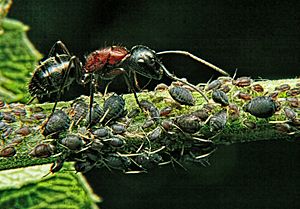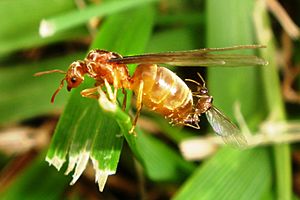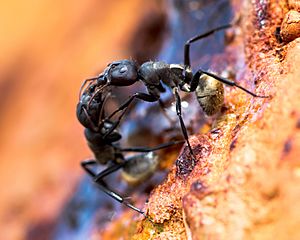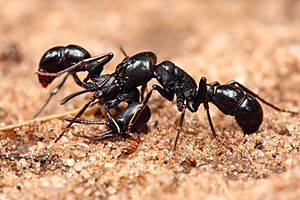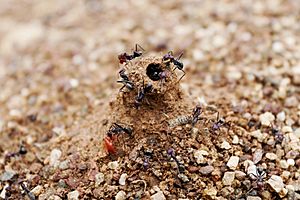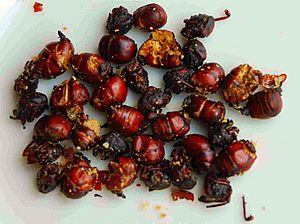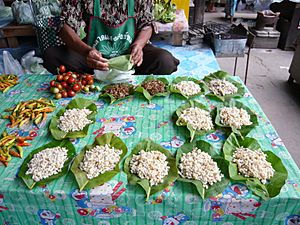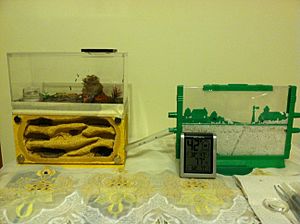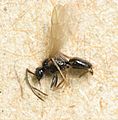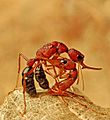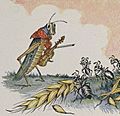Ant facts for kids
Quick facts for kids Ants |
|
|---|---|
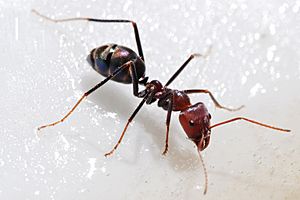 |
|
| Meat eater ant feeding on honey | |
| Scientific classification | |
| Kingdom: | |
| Phylum: | |
| Class: | |
| Order: | |
| Suborder: | |
| Superfamily: | |
| Family: |
Formicidae
|
Ants are social insects that belong to the family Formicidae. They are related to wasps and bees. There are about 22,000 different types of ants in the world, and over 12,500 of them have been named and studied.
Ants have a special body shape with a thin waist and bent antennae. They live in groups called colonies. Some colonies are small with only a few dozen ants. Others are huge, covering large areas and having millions of ants. Ants are usually small, but they are very strong. A worker ant can carry things that are 20 times its own weight! These worker ants bring food back to the colony for the other ants and the queen to eat.
This article will tell you more about ants, especially those that live in large colonies.
Contents
Ant Colonies
Every ant colony has a female ant called a queen. Her job is to lay eggs. These eggs will hatch and grow into worker ants. In large colonies with millions of ants, most of the ants are female. They form different groups called workers, soldiers, or other special castes. Almost all ant colonies also have some fertile male ants, which are called drones.
Ant colonies are sometimes called 'superorganisms'. This is because all the ants work together like one big living thing to help the colony survive. Ants live almost everywhere on planet Earth. The only places without ants are Antarctica and a few very remote islands.
How Ants Evolved
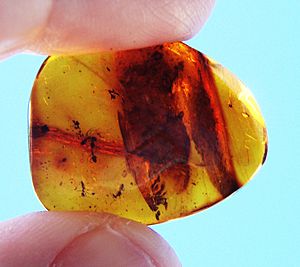
Ants are part of a group of insects called Hymenoptera. This group also includes sawflies, bees, and wasps. Scientists believe that ants evolved from a type of wasp.
Studies suggest that ants first appeared a very long time ago, about 110 to 140 million years ago. This was during the time of the dinosaurs! After flowering plants started to grow about 100 million years ago, ants began to spread out and become more common. They became a very important part of the environment about 60 million years ago.
In the past, ants were not as common as other insects. But after a period of rapid growth and change, they became very dominant. By the time of the Oligocene and Miocene epochs, ants made up 20-40% of all insects found in fossils.
It's important to know that Termites are sometimes called white ants, but they are not true ants. Termites are actually more closely related to cockroaches. Even though termites also live in social colonies, they are very different from ants. Also, Velvet ants look like big ants, but they are actually female wasps without wings.
Ant Body Parts
Ants have a unique body shape that makes them different from other insects. They have bent antennae, special glands on their sides, and a very narrow waist called a petiole. An ant's body has three main parts: the head, the mesosoma, and the metasoma. The petiole forms a thin connection between the mesosoma (which includes the thorax) and the gaster (the main part of the abdomen).
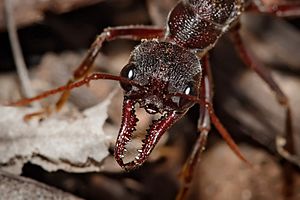
Like other insects, ants have an exoskeleton. This is a hard outer shell that protects their body and gives their muscles something to attach to. It's like a suit of armor! Ants don't have lungs. Instead, they breathe through tiny holes in their exoskeleton called spiracles. Oxygen goes in and carbon dioxide goes out through these holes.
Ants also don't have blood vessels like humans. They have a long, thin tube along their back that acts like a heart. It pumps a fluid called haemolymph around their body. Their nervous system is a cord that runs along their body with small groups of nerve cells called ganglia.
The Head
An ant's head has many important sensory organs. Like most insects, ants have compound eyes. These eyes are made of many tiny lenses joined together. They are good at spotting movement, but they don't see very clear pictures. Ants also have three small simple eyes called ocelli on top of their head. These help them detect light levels and how light is angled. Most ants don't have great eyesight, and some ants that live underground are completely blind. However, some ants, like the bulldog ant from Australia, have excellent vision. They can see objects moving almost a meter away!
Ants have two antennae (feelers) attached to their head. These are super important! They use them to smell chemicals, feel air currents, and detect vibrations. They also use their antennae to touch other ants and send signals. The head also has two strong jaws called mandibles. Ants use these jaws to carry food, build nests, and defend themselves. Some ants even have a small pocket inside their mouth to store food. This food can then be shared with other ants or their young.
The Mesosoma
The legs and wings of an ant are attached to its mesosoma (the middle part of its body). The legs end in a hooked claw, which helps them grip and climb surfaces. Only reproductive ants, like queens and males, have wings. After a queen mates, she breaks off her wings. You can often see small stubs where her wings used to be. In a few ant species, the queens and males don't have wings at all.
The Metasoma
The metasoma (the "abdomen") is the last part of the ant's body. It holds important internal organs, including those for reproduction, breathing, and getting rid of waste. Many worker ants have their egg-laying parts changed into stings. They use these stings to catch prey and protect their nests.
Ant Life Cycle and Reproduction
An ant's life begins as an egg. If the egg is fertilized, it will become a female ant. If it's not fertilized, it will become a male ant. Ants go through a process called complete metamorphosis. This means they change completely as they grow. They start as an egg, then become a larva, then a pupa, and finally an adult ant. Worker ants feed and care for the larvae.
Ants share food with their larvae and other adult ants through a process called trophallaxis. This is when an ant brings up liquid food from its stomach and shares it. Larvae might also get solid food that foraging workers bring back. They can even be taken to captured prey in some species. As larvae grow, they shed their skin several times and then enter the pupal stage.
The type of food larvae eat can sometimes decide if they become a queen or a worker (both are female). It can also affect what kind of worker they become. This is a complex process that scientists are still studying.
A new worker ant spends its first few days caring for the queen and the young ants. Then, it starts digging and doing other nest work. Later, it will defend the nest and go out to find food. These jobs change as the ant gets older. This is because foraging for food can be dangerous. It makes sense for older ants to take these risks, as they are closer to the end of their lives anyway.
Mating and Nuptial Flight
Most ant species have a system where only the queen and certain breeding females can mate. Some ant nests can even have more than one queen!
The winged male ants, called drones, hatch from pupae at the same time as the breeding females. Drones don't do much except eat and mate.
Each year, most ants produce a new generation. During the breeding season, new winged males and females leave the colony. This event is called a nuptial flight. The males usually fly first. They use landmarks to find a special mating spot where other males gather. Males also release a special scent called a pheromone that females follow.
Some female ants mate with only one male, but others might mate with many different males. After mating, the females look for a good place to start a new colony. They break off their wings and begin to lay and care for eggs. The females store the sperm they got during their flight to fertilize future eggs.
The first worker ants to hatch are often smaller and weaker. But they immediately start helping the colony. They make the nest bigger, find food, and care for the other eggs. This is how most new ant colonies begin. In species with multiple queens, a queen might leave the nest with some workers to start a new colony. This is similar to how honeybees swarm.
Ant colonies can live for a very long time. Queens can live up to 30 years! Worker ants live for 1 to 3 years. Males, however, only live for a few weeks. Ant queens live much longer than other insects of the same size.
Ants are active all year in warm places. But in cooler regions, they become inactive during winter. This is like a long sleep. Some species have their young (larvae) go into this inactive state, while in others, only the adult ants slow down their activity.
Ant Behavior and Ecology
How Ants Communicate
Ants communicate with each other in amazing ways. They use special chemicals called pheromones, sounds, and touch. Ants are very good at using pheromones as signals. They smell with their long, thin, and movable antennae. Their paired antennae help them figure out the direction and strength of a scent.
Since most ants live on the ground, they leave pheromone trails on the soil. Other ants can follow these trails. When an ant finds food, it marks a trail back to the colony. Other ants follow this trail, and as they bring food back, they make the trail stronger. When the food source is gone, no new trails are marked, and the scent slowly fades away. This helps ants adapt to changes. For example, if a path to food is blocked, foragers will explore new routes. If an ant finds a shorter way, it leaves a new trail. More ants will follow the best trails, making them stronger and helping the colony find the most efficient path.
Ants use pheromones for more than just trails. If an ant is crushed, it releases an alarm pheromone. This makes nearby ants go into attack mode and attracts more ants from farther away. Some ants even use "propaganda pheromones" to confuse enemy ants, making them fight each other!
Some ants also make sounds by rubbing parts of their body together. These sounds might be used to talk to other ants in their colony or even to other species.
Ant Defenses
Ants defend themselves by biting. Many species also sting. When they sting, they often inject or spray chemicals. For example, some ants spray formic acid. Fire ants inject chemicals called alkaloids. Bullet ants, found in Central and South America, have the most painful sting of any insect. Luckily, it's usually not deadly to humans. The sting of jack jumper ants can be dangerous, and there's even an antivenom for it.
Fire ants have a special venom sac with unique chemicals. Their stings are painful and can be dangerous for people who are very sensitive to them.
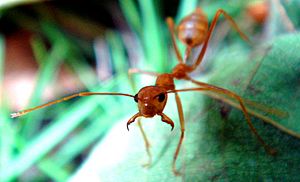
Trap-jaw ants, like those in the genus Odontomachus, have jaws that snap shut faster than any other animal part! They can close their jaws at speeds up to 230 kilometers per hour. These ants also use their jaws like a catapult. They can launch intruders away or even fling themselves backward to escape danger.
A species of ant in Malaysia, Camponotus cylindricus, has large glands that extend into their abdomen. When disturbed, these ants can burst their abdomen, releasing chemicals that stop small insect attackers. The worker ant then dies.
Besides fighting predators, ants also need to protect their colonies from germs. Some worker ants keep the colony clean. They even act as "undertakers," carrying away dead nest-mates.
Ant nests are often built in clever ways to protect them from dangers like floods and overheating. Some ants that live in plant hollows will drink water inside the nest during a flood and then carry it outside. Other ants that live in wood in swampy areas can survive being underwater by changing how they breathe.
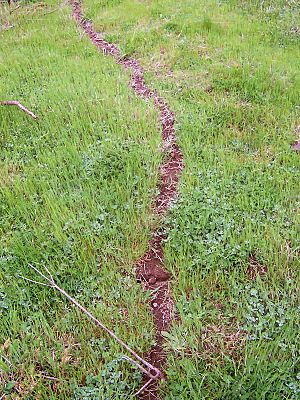
Ants that go out to find food can travel long distances, sometimes up to 200 meters from their nest. Scent trails help them find their way back, even in the dark. In hot, dry places, ants that forage during the day risk drying out. So, finding the shortest way back to the nest is very important.
Desert ants, like the Sahara desert ant, navigate by keeping track of their direction and how far they've traveled. They measure distance by counting their steps and by how objects move in their vision. They figure out direction by using the position of the sun. They combine all this information to find the shortest route back to their nest.
Like all ants, they can also use landmarks, smells, and touch to find their way. Some ant species can even use the Earth's magnetic field for navigation. The compound eyes of ants have special cells that can detect polarized light from the Sun. This helps them figure out direction. These light detectors are sensitive to ultraviolet light.
In some army ant species, if a group of foragers gets separated from the main group, they might start running in a circle. This is called an ant mill. The ants can keep running until they die from exhaustion.
Ants as Food
Ants and their larvae (young ants) are eaten in different parts of the world. In Mexico, the eggs of two ant species are used to make a dish called escamoles. This is considered a type of insect caviar and can be very expensive because it's hard to find. In Colombia, large-bottomed ants called hormigas culonas are toasted alive and eaten.
In parts of India, Burma, and Thailand, a paste made from green weaver ants is served with curry. Weaver ant eggs and larvae are also used in a Thai salad called yam khai mot daeng, or red ant egg salad. This dish comes from the northeastern part of Thailand.
Ants as Pets
From the 1950s to the 1970s, ant farms were popular educational toys for children in the United States. Some newer ant farms use clear gel instead of soil. This lets you see the ants better, but it can also stress the ants because of the unnatural light.
Related pages
Images for kids
-
A leaf nest built by weaver ants in Pamalican, Philippines.
-
Myrmecocystus, honeypot ants, store food to prevent the colony from running out.
-
Meat-eater ants feeding on a cicada: social ants work together to gather food.
-
The spider Myrmarachne plataleoides (female shown) looks like weaver ants to avoid predators.
-
An ant collecting honeydew from an aphid.
-
Ants may get nectar from flowers like the dandelion, but they rarely pollinate them.
-
A meat ant taking care of a common leafhopper nymph.
-
Weaver ants are used to control pests in citrus farms in southern China.
-
The tiny pharaoh ant is a big pest in hospitals and offices; it can build nests between sheets of paper.
-
Aesop's ants: an illustration by Milo Winter.
See also
 In Spanish: Hormigas para niños
In Spanish: Hormigas para niños


